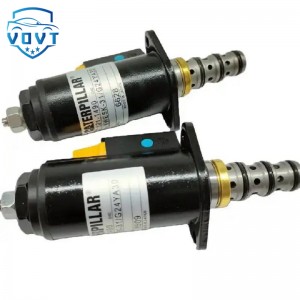New High Quality Diesel Nozzle DLLA162P2160 for Injection Nozzle 0 433 172 160 0433172160 Diesel Engine Parts
Products Description
| Reference. Codes | DLLA162P2160 |
| Application | / |
| MOQ | 12PCS |
| Certification | ISO9001 |
| Place of Origin | China |
| Packaging | Neutral packing |
| Quality Control | 100% tested before shipment |
| Lead time | 7~15 working days |
| Payment | T/T, L/C, Paypal, Western Union, MoneyGram or as your requirement |
What effect does fuel pressure have on the atomization effect of the injector nozzle?
1. The core mechanism of fuel pressure on atomization effect
The essence of fuel atomization is the "kinetic energy conversion" and "fluid fragmentation" process when high-pressure fuel passes through the nozzle:
When high-pressure fuel enters the nozzle of the injector, the pressure energy is converted into high-speed kinetic energy (the flow rate can reach 300-500m/s, close to the speed of sound);
The high-speed fuel flow collides and shears violently with the air at the nozzle outlet (or the gas inside the combustion chamber), and is torn into fine oil droplets to form oil mist.
The influence of pressure on this process is mainly reflected in three aspects:
Droplet size: the higher the pressure, the finer the oil mist
At low pressure (such as <500bar): the fuel flow rate is low, the shear force with the air is weak, the oil droplet size is large (may exceed 100 microns), and it is easy to appear "oil columnar" spray, uneven atomization.
At high pressure (such as 1000-3000bar): the flow rate increases dramatically, the shear force and turbulence intensity increase significantly, the fuel is broken into 5-30 micron oil droplets (close to smoke particles), and the oil mist is more evenly distributed.
For example: in the common rail system, when the pressure increases from 1000bar to 2000bar, the average particle size of the oil droplets can be reduced by 30%-50%, and the combustion area increases significantly.
Spray penetration: pressure determines the diffusion range of the oil mist
Pressure is too low: the spray kinetic energy is insufficient, the oil mist penetration is weak, and it is easy to concentrate near the nozzle, resulting in excessive fuel concentration in the combustion chamber (incomplete combustion), while the air in the distance is not fully utilized.
Pressure is too high: the spray penetration is too strong, and the oil mist may directly impact the combustion chamber wall or the top of the piston, causing the fuel to adhere to form carbon deposits (especially when the nozzle angle is not designed reasonably).
Balance principle: the pressure must match the shape of the combustion chamber and the nozzle angle to ensure that the oil mist covers the entire combustion chamber and does not hit the wall.
Spray cone angle and distribution: Pressure affects the diffusion form of oil mist
At low pressure: the "expansion force" of the fuel outflowing from the spray hole is weak, the spray cone angle is small (such as < 20°), and the oil mist is concentrated in a small area, which can easily lead to local hypoxia.
At high pressure: the high-speed fuel flow forms strong turbulence at the outlet, the spray cone angle increases (can reach 30°-60°), the oil mist diffuses more evenly, and can be fully mixed with the air in the combustion chamber.
2. Specific performance of atomization effect in different pressure ranges (taking common fuel systems as an example)
Fuel system type Typical pressure range (bar) Atomization effect characteristics Applicable scenarios
Traditional mechanical injection system 300-700 Large oil droplet size (50-100 microns), coarse atomization Old diesel engines (such as tractors, trucks)
Electronic control common rail system (early) 1000-1600 Oil droplet size 30-50 microns, more uniform atomization Passenger cars, light commercial vehicles
High-pressure common rail system (latest) 2000-3000 Oil droplet size 5-30 microns, fine and evenly distributed atomization National VI / Euro VI emission standard models
Note: The higher the pressure, the more stringent the requirements for the material (such as high-strength alloy) and processing accuracy (spray hole tolerance ±0.005mm) of the injector nozzle, otherwise the spray hole is easily deformed or worn due to high pressure, which will damage the atomization.
3. Negative impact of pressure fluctuation on atomization
Even if the average pressure meets the standard, pressure fluctuations (such as instantaneous pressure drop or pulse) will seriously damage the stability of atomization:
When the fluctuation amplitude exceeds 5%, the oil droplet size deviation may reach more than 20%, resulting in uneven spray at different times in the same cycle;
Long-term fluctuations will aggravate the wear of the nozzle hole (due to pressure shock), further deteriorate the atomization effect, and form a "vicious cycle".
Therefore, modern fuel systems (such as common rail systems) control pressure fluctuations within ±2% through high-pressure pump flow control and rail pressure sensor feedback adjustment to ensure stable atomization.
IV. Relationship with other factors: Pressure is not the only determining factor
The influence of fuel pressure needs to work in conjunction with the following factors:
Nozzle parameters: small diameter nozzles (such as 0.1-0.2mm) have finer atomization at the same pressure, but require higher pressure to drive (otherwise it is easy to clog);
Fuel viscosity: fuel viscosity increases at low temperatures, and higher pressure is required to achieve the same atomization effect (such as rail pressure usually increases by 20%-30% during cold start);
Injector response speed: needle valve opens/closes faster (milliseconds) under high pressure, which can reduce atomization inconsistency caused by "injection hysteresis".





















